Biofuels
-
- Future Marine Fuels: BioFuels in Focus Maritime Reporter, Mar 2016 #24
It is predicted that biofuels will make up 5-10% of the global marine fuel mix by 2030 – meaning that biofuels will represent a crucial role in creating a low-emission future for shipping.In the wake of COP 21 and in advance of any subsequent IMO ruling on the environment, it may seem to many that the shipping industry is in limbo when it comes to improving its emissions footprint. On the contrary, ship owners and operators are increasingly looking for ways to ensure that both existing fleets and new builds maximize their business potential, while at the same time keeping up with industry regulation and initiatives to combat climate change.First, there is a tightening range of environmentally conscious legislation coming in to force – including the impending roll out of Emissions Control Areas in China. This adds to existing control areas in North America and the Baltic Sea, meaning that the global scope of this kind of legislation will only continue to expand in the next five years and beyond.In addition, new IMO NOx Tier III requirements will take effect in North American and U.S. Caribbean ECAs from January 1, 2016 for vessels with a keel-laying date on or after January 1, 2016 and an engine output of ≥130kW. And then there is also the European Commission’s Monitoring, Reporting and Verification (MRV) rules to consider: in force from July 1, 2015, this legislation dictates that operators of ships exceeding 5000 GT must monitor and report their carbon emissions on all voyages to, from and between EU ports from 2018.Given these legislative developments, there has never been a better time for ship owners and operators to stand back and re-examine business decisions so as to not fall foul of the new laws.In the case of reducing emissions, there are already a few potential solutions on the market – installing scrubbers, which requires significant investment, for example, or transitioning a vessel to use LNG as a fuel, which not only requires investment, but also has a long way to go before the global infrastructure is capable of effectively supporting vessels worldwide.There is a viable alternative, however, steadily emerging onto the market, with every indication that it is about to shake up the marine fuel mix in a big way. It is predicted that biofuels will make up 5-10% of the global marine fuel mix by 2030 – meaning that biofuels will represent a crucial role in creating a low-emission future for shipping.Sustainable marine biofuels replace fossil fuels and significantly reduce both local emissions such as SOx and particulate matter (PM), but most significantly, they can enable significant reductions in levels of CO2 of 80-90%. It is this emissions reduction that is one of the main draws for ship owners and operators – not only because of the environmental benefits – but because growing numbers of ports across the world are incentivising greener shipping.Some major global ports are now offering incentives for vessels that exceed environmental targets. For example the Environmental Ship Index (ESI), adopted by nearly 40 ports worldwide, evaluates NOx and SOx emissions and rewards vessels by offering a reduction in port dues. In certain ports this has also been extended to include particulates, a group of pollutants that includes carbon monoxide (CO), carbon dioxide and black carbon solids (soot).Shipping is the last of the major transport modes to turn its eye to biofuels as way of becoming less emission-intensive. As was the case in the jet biofuel market, the first volumes are likely to geographically concentrate on where the incentives are. The same “usage hotspots” are therefore anticipated for shipping, in, for example, Western Europe, the Nordics, west coast North America, followed by Australia, Asia and so on.The benefits of biofuels don’t stop there, however; their ability to be used as a ‘drop in’ fuel (put simply, to blend with traditional fossil fuels) is critical, as it ensures that current logistical and operational systems can remain in place and every party can stay in a ‘business-as-usual’ mode.This in turn ensures that sustainable biofuel requires no investment in infrastructure; all that is required is a standard fuel tank and ex-pipe facility at berth or a standard bunker barge.The lack of initial outlay to make a vessel ready to use biofuels is compelling. Installing scrubbers or making a vessel LNG-ready costs both time and money – costs that operators can scarcely afford to incur given the current market conditions, especially when low oil prices have now elongated payback projections.Any time spent in port is time not spent at sea – and this is notwithstanding any losses in capacity that may come from refitting a new system, permanently diminishing the profit margin of operating the vessel on every future journey.Furthermore, biofuels are a clean, high performance fuel that produces less sludge waste than fossil fuels, which ultimately means that their usage requires less engine maintenance than ship operators will be accustomed to.Given all of these reasons, the adoption of biofuels is now an emerging strategy – one that is particularly reinforced by their drop-in nature and instant, quantifiable benefits in terms of a reduced emissions profile. Every indication is that, over the next few years, the sustainable marine biofuels market will quickly evolve to cement them as a core component in achieving a more sustainable, low-emission future for shipping.About the AuthorCEO Dirk Kronemeijer founded the GoodNRG Group after pioneering the market of bio aviation fuels with SkyNRG - the global market leader in sustainable aviation fuel. GoodFuels Marine is part of the GoodNRG Group. It is the first company focused on creating the market for sustainable marine fuels and supports the prediction that biofuels will form 5-10% of the total global marine fuel mix by 2030. Dirk Kronemeijer (1974) achieved his MSc in Business Economics from the University of Groningen and he completed executive programs at the International Institute for Management Development (IMD) and INSEAD.As published in the March 2016 edition of Maritime Reporter & Engineering News - http://digitalmagazines.marinelink.com/nwm/MaritimeReporter/201603/ -
- Scripps Institution of Oceanography: 3D-printed Coral Are Natural Producers of Biofuels Marine Technology, May 2020 #47
capable of growing dense microscopic algae populations. The work is aimed at the development of compact, efficient bioreactors for producing algae-based biofuels and could lead to a better understanding of the coral-algae relationship, with the hopes of establishing techniques to repair and restore reefs.Author
-
- Scripps Institution of Oceanography: 3D-printed Coral Are Natural Producers of Biofuels Marine Technology, May 2020 #47
capable of growing dense microscopic algae populations. The work is aimed at the development of compact, efficient bioreactors for producing algae-based biofuels and could lead to a better understanding of the coral-algae relationship, with the hopes of establishing techniques to repair and restore reefs.Author
-
- Future Ship Fuels: Cut through the Smoke Maritime Reporter, Feb 2020 #20
has an impact on the environment (limiting their potential to reduce lifecycle emissions) and they compete for food crops, this first generation of biofuels is controversialAnother proposed biofuel is HVO (hydro-treated vegetable oil), which has a high-energy content, similar to MGO. HVO can be produced
-
- Cruise Ships & Eco-Trends in Energy Transition Maritime Reporter, Feb 2018 #44
such fuel in sight, the industry looks to develop alternative options available today or in the foreseeable future such as liquefied natural gas (LNG) and biofuels. Alternative Fuels Liquefied Natural Gas (LNG) is a clear, odorless, and non-toxic liquid, formed when natural gas cooled to -162C (-260F)
-
- Maritime 2050: Facing the Decarbonization Challenge Maritime Reporter, Oct 2019 #58
of their energy being provided by grid electricity.Source: DNV GLWe have lower and potentially carbon neutral options in use today, with LNG, electric, biofuels, and biofuels for example. But in the context of ship fuel, what does it mean to be carbon neutral? This is an important concept for the industry
-
- MAN ES: Moving Forward on Ammonia Engines Maritime Reporter, Jan 2023 #18
, that is starting to evolve too as LNG is not the fuel to get shipowners over the 2050 emissions hump. A broad array of new fuels – including SNG, biofuels, hydrogen, methanol and ammonia – are entering the mix as shipowners eye options that will enable them to more easily reach ever stricter emission
-
- Powering the North American Maritime Fuel Transition Maritime Reporter, Apr 2023 #16
that electrification, with its need for recharging, made sense in fleet boats and towing vessels not working continuously.The authors noted that: “Biofuels and methanol are feasible non-fossil fuel alternatives because they can be used in some existing marine engines and are supported by current infrastructure
-
- MN 100: PPG Protective & Marine Coatings Marine News, Aug 2014 #59
biocides. The NOVAGUARD coating is a one-coat system. This solvent-free phenolic epoxy coating improves work safety, and has wide chemical resistance to biofuels, crude oil and unleaded gasolines, providing maximum storage flexibility. Strategically located storage depots and color network centers support PPG‘s
-
- LNG as the Ultimate Solution? Not so fast … Maritime Logistics Professional, Q1 2013 #48
, we determined that we could produce a diesel engine that could run on seven different alternative fuels. From a technology perspective – whether it is biofuels, different gases, we have the technology to produce these engines – so it is not an engineering challenge.” Volvo Penta, despite deep roots in gas
-
- A New Reef Biome Under the Amazon Plume Marine Technology, Sep 2016 #14
along the deeper shallow waters off the Amazon River basin and the EM. Knowing this lack of hard data on the EM, the ANP, Brazil’s National Petroleum and Biofuels Agency, states in its 11th round auction documents that environmental impact licenses for blocks in the EM may be impacted and even revoked depending
-
- A look inside Emily Penn’s eXXpedition Marine Technology, Aug 2020 #34
in Australia, Penn looked for ways to hitchhike from England on a boat. She managed to join an expedition that was crossing the world’s oceans on biofuels and was shocked throughout the trip by the amount of plastic waste they encountered. From floating masses in the middle of the ocean to cluttered
-
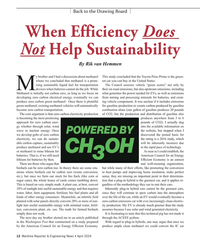 )
April 2024 - Maritime Reporter and Engineering News page: 12
)
April 2024 - Maritime Reporter and Engineering News page: 12Council for an Energy lithium for batteries by then. Ef? cient Economy is an earnest There are those who argue that and well-meaning organization, biofuels can be zero carbon too. In theory there are some situ- but while many of their efforts, like promoting the conversion ations where biofuels can be
-
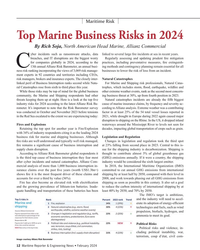 )
February 2024 - Maritime Reporter and Engineering News page: 12
)
February 2024 - Maritime Reporter and Engineering News page: 12target is ambitious, and the industry will need to accel- erate its adoption of energy-ef? cient technologies and fuels, such as wind propulsion, biofuels, hydrogen, and ammonia to meet its goal. Political Risks Political risks and violence, in- cluding political instability, war, terrorism, coup d’état
-
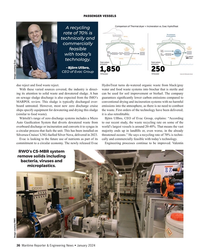 )
January 2024 - Maritime Reporter and Engineering News page: 36
)
January 2024 - Maritime Reporter and Engineering News page: 36PASSENGER VESSELS A recycling rate of 70% is technically and commercially feasible with today’s technology. – Björn Ullbro, CEO of Evac Group due reject and food waste reject. HydroTreat turns de-watered organic waste from black/gray With these varied sources covered, the industry is direct- water
-
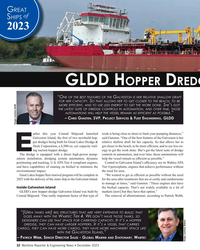 )
December 2023 - Maritime Reporter and Engineering News page: 32
)
December 2023 - Maritime Reporter and Engineering News page: 32G REAT of HIPS S 2023 GLDD H DOPPER REDG NE OF THE BEST FEATURES OF THE ALVESTON IS HER RELATIVE SHALLOW DRAFT FOR HER CAPACITY O THAT ALLOWS HER TO GET CLOSER TO THE BEACH TO BE MORE EFFICIENT AND TO USE LESS ENERGY TO GET THE WORK DONE HE S GOT THE LATEST SUITE OF DREDGE CONTROLS IN AUTOMATION AND
-
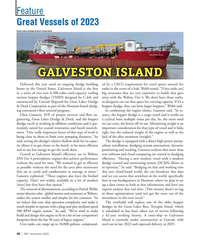 )
November 2023 - Marine News page: 48
)
November 2023 - Marine News page: 48Feature Great Vessels of 2023 Great Lakes Dredge & Dock Corporation GALVESTON ISLAND Delivered this year amid an ongoing dredge building ed by a USCG requirement for crawl spaces around the boom in the United States, Galveston Island is the ? rst tanks in the event of a leak, Webb noted. “[Urea tanks
-
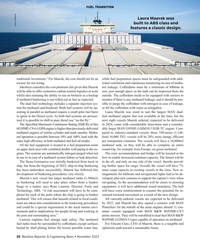 )
November 2023 - Maritime Reporter and Engineering News page: 28
)
November 2023 - Maritime Reporter and Engineering News page: 28customers carbon neutral logistics at scale size, just enough space so the tank can be inspected from the whilst also retaining the ability to run on biofuels as a backup outside. The cofferdam needs to be equipped with sensors to if methanol bunkering is not rolled out as fast as expected. monitor if
-
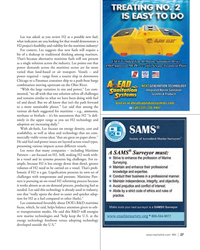 )
October 2023 - Marine News page: 27
)
October 2023 - Marine News page: 27that isn’t the path forward to a more sustainable planet.” Lee said that among the various alt-fuels suggested for maritime – e.g., ammonia, methane or biofuels – it’s his assessment that H2 “is de? - nitely in the upper range as you see H2 technology and adoption are increasing daily.” With alt-fuels, Lee
-
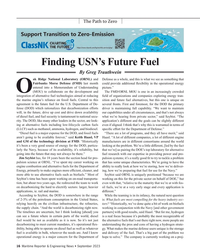 )
September 2023 - Maritime Reporter and Engineering News page: 16
)
September 2023 - Maritime Reporter and Engineering News page: 16to make engines more ef? cient, cleaner, and ing, how we’re preparing that fuel for use for the Navy.” more able to use alternative fuels such as biofuels.” Most of Szybist said ORNL is uniquely positioned “because we are Szybist’s time has been spent working on on-road transporta- working on this
-
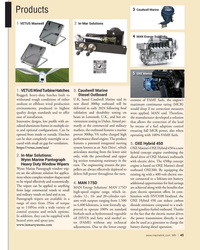 )
June 2023 - Marine News page: 45
)
June 2023 - Marine News page: 45to 110Nm with a wide variety of proved to operate 100% on standard tional gasoline-fueled outboard. Thanks control systems and switch options. biofuels such as hydrotreated vegetable to the fact that the electric motor drives In addition, they can be supplied with oil (HVO) and fatty acid methyl
-
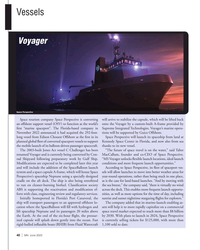 )
June 2023 - Marine News page: 40
)
June 2023 - Marine News page: 40Vessels Voyager Space Perspective Space tourism company Space Perspective is converting will arrive to stabilize the capsule, which will be lifted back an offshore support vessel (OSV) to function as the world’s onto the Voyager by a custom-built A-frame provided by ? rst “marine spaceport”. The
-
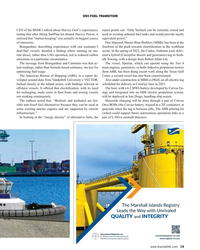 )
April 2023 - Maritime Reporter and Engineering News page: 19
)
April 2023 - Maritime Reporter and Engineering News page: 19OSV FUEL TRANSITION CEO of the BSMC) talked about Harvey Gulf’s experiences, report points out: “Only biofuels can be currently stored and noting that after ? tting SailPlan kit aboard Harvey Power, it used in existing onboard fuel tanks and would provide nearly realized that “station-keeping” was
-
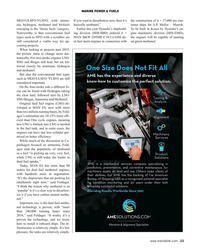 )
January 2023 - Maritime Reporter and Engineering News page: 23
)
January 2023 - Maritime Reporter and Engineering News page: 23POWER & FUELS MGO/ULSFO/VLSFO; with ammo- If you want to decarbonize now, then it’s the construction of 6 × 17,000 teu con- nia, hydrogen, methanol and biofuels basically methanol.” tainer ships for A.P. Moller – Maersk. emerging in the ‘future fuels’ category. Earlier this year Hyundai’s shipbuild- To
-
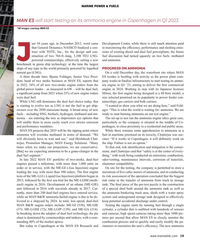 )
January 2023 - Maritime Reporter and Engineering News page: 19
)
January 2023 - Maritime Reporter and Engineering News page: 19Fold- owners over the 2050 emissions hump. A broad array of new ager. “This is what the world is waiting for: ammonia. We are fuels – including SNG, biofuels, hydrogen, methanol and am- ready to start burning ammonia on our test engine.” monia – are entering the mix as shipowners eye options that The set-up
-
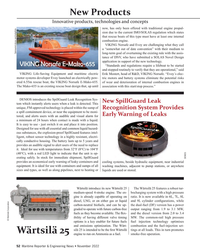 )
November 2022 - Maritime Reporter and Engineering News page: 52
)
November 2022 - Maritime Reporter and Engineering News page: 52of operating on ratio. It is now available in 6L, 7L, 8L diesel, LNG, or on either gas or liquid and 9L cylinder con? gurations, while carbon-neutral biofuels, and can be up- the dual-fuel (DF) version has a power graded to operate with future carbon-free output ranging from 1.9 to 3.1 MW, fuels as they
-
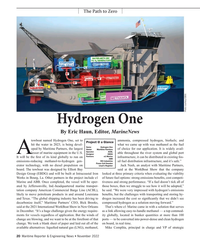 )
November 2022 - Maritime Reporter and Engineering News page: 20
)
November 2022 - Maritime Reporter and Engineering News page: 20courtesy EBDG Hydrogen One By Eric Haun, Editor, MarineNews towboat named Hydrogen One, set to Project @ a Glance ammonia, compressed hydrogen, biofuels; and hit the water in 2023, is being devel- what we came up with was methanol as the fuel Name Hydrogen One oped by Maritime Partners, the largest
-
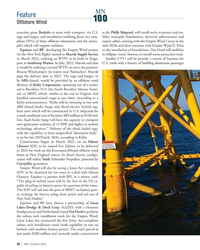 )
October 2022 - Marine News page: 26
)
October 2022 - Marine News page: 26MN Feature Offshore Wind struction giant Boskalis to assist with transport, via U.S. at the Philly Shipyard, will install rocks to protect and sta- tugs and barges, and installation (utilizing Jones Act com- bilize monopile foundations, electrical substructures and pliant PSVs) of three offshore substation
-
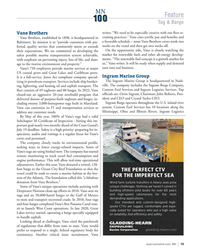 )
October 2022 - Marine News page: 19
)
October 2022 - Marine News page: 19MN Feature Tug & Barge writes: “We need to be especially creative with our ? eet re- Vane Brothers Vane Brothers, established in 1898, is headquartered in cruiting practices.” Vane cites terri? c pay and bene? ts and a favorable schedule – most Vane Brothers crews work two Baltimore. Its mission is to
-
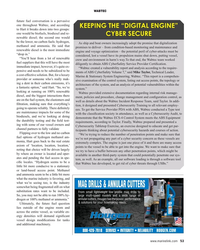 )
August 2022 - Maritime Reporter and Engineering News page: 53
)
August 2022 - Maritime Reporter and Engineering News page: 53conversation is a pervasive one throughout Wabtec, and according KEEPING THE “DIGITAL ENGINE” to Hart it breaks down into two groups: one would be biofuels, biodiesel and re- CYBER SECURE newable diesel; the second one would be the lower, no carbon fuels: hydrogen, As ship and boat owners increasingly
-
 )
August 2022 - Maritime Reporter and Engineering News page: 21
)
August 2022 - Maritime Reporter and Engineering News page: 21to make use of alternative fuels and technology to start reduc- like LNG and biofuel. The ? rst large bulk carriers to use LNG ing its emissions right away. entered service in 2022 while LNG powered RoRo vessels Decarbonization will transform the shipping industry’s risk and tankers are under construction
-
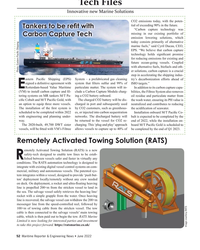 )
June 2022 - Maritime Reporter and Engineering News page: 52
)
June 2022 - Maritime Reporter and Engineering News page: 52capture technology holds signi? cant promise for reducing emissions for existing and future ocean-going vessels. Coupled with alternative fuels, biofuels and oth- er solutions, carbon capture is a crucial Photo: Eastern Paci? c Shipping step in accelerating the shipping indus- astern Paci? c Shipping
-
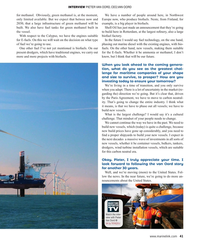 )
June 2022 - Maritime Reporter and Engineering News page: 41
)
June 2022 - Maritime Reporter and Engineering News page: 41, at the moment, We have a number of people around here, in Northwest only limited available. But we expect that betwee now and Europe now, who produce biofuels. Neste, from Finland, for 2030, that a large infrastructure of green methanol will be example, is a big player in biofuels. built. We also have
-
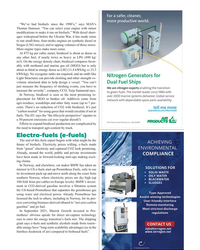 )
May 2022 - Maritime Reporter and Engineering News page: 33
)
May 2022 - Maritime Reporter and Engineering News page: 33“We’ve had biofuels since the 1990’s,” says MAN’s Thomas Hanssen. “You can select your engine with minor modi? cations to make it run on biofuels.” With diesel short- ages widespread before the Ukraine War, it has made sense to run small-bore, four-stroke engines on synthetic diesel or biogas (LNG-mixes)
-
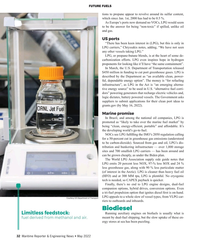 )
May 2022 - Maritime Reporter and Engineering News page: 32
)
May 2022 - Maritime Reporter and Engineering News page: 32a whole slew of vessel types, from VLPG car- Courtesy US Department of Transport riers to outboards and inboards. Biodiesel Running auxiliary engines on biofuels is usually what is Limitless feedstock: meant by dual-fuel shipping, but the slow uptake of these en- fuel derived from methanol and air. ergy stores
-
 )
May 2022 - Maritime Reporter and Engineering News page: 24
)
May 2022 - Maritime Reporter and Engineering News page: 24fuels. A survey suggests “no one really knows” which future fuels will survive, or which of ammonia, hydrogen, methanol, LNG, LPG or additives-rich biofuels might dominate. Changing rules, war and tech disruption make following along key. BY WILLIAM STOICHEVSKI 24 Maritime Reporter & Engineering News
